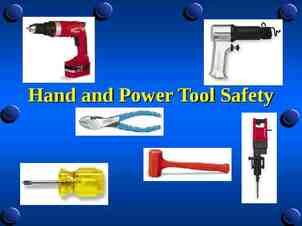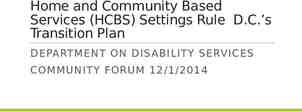A Partnership For Safety: Coordinating Emergency Responses on
26 Slides1.70 MB
A Partnership For Safety: Coordinating Emergency Responses on Limited Access Highways I-295 / I-76 / NJ 42 Incident Management Task Force in New Jersey Frank Lafferty, Jr. Haddon Heights Fire Department, NJ
Policy and Procedures Manual
What Was the Problem? Significant incidents on the highway posed safety and communications issues The need for dual county response Who’s in charge? Timely transmission of critical information Lack of Interoperability
A Breakdown in Communications Agencies that respond on the highway operate on different frequencies Multiple fire departments responding to the same incident could be on different frequencies EMS operated on a separate frequency Inter-county communications caused delays in dispatch
Depending On Where You Are
Or Worse Yet I-676 / I-76 Interchange
Purpose Statement Provide responders uniform operational guideline for safe operations at the scene of an incident. This document serves as a guideline for decision-making and can be modified by the incident responders as necessary to address existing conditions.
Goal Improving the overall traffic incident management process will – Improve the safety of responding agency personnel – Reduce the chance of an associated traffic accident – Minimize the amount of apparatus and number of personnel responding onto the highway
Unified Incident Management System The New Jersey State Police have statutory authority over ALL incidents which occur on highways covered by this document. The senior trooper is the incident manager. In keeping with the Incident Management System – The senior fire department officer is designated as the fire branch. The fire branch leader will utilize proper radio designation i.e. Route 42 Command
Unified Incident Management System Agencies responding to incidents in the response area covered by this document will utilize an Unified Incident Management System. – The first arriving emergency responder will establish command Identify the command post location Don a reflective vest for identification – All other responding agencies will send a representative to the command post.
Unified Incident Management System Agencies will cooperate and work together for the safe and efficient mitigation of the incident. All strategic decisions must be communicated to ALL other participating agencies to ensure coordinated effort. New Jersey State Police will have the final say should any disputes arise.
Lane Identification For uniformity travel lanes will be numbered in an ascending order from high speed lane to low speed lane (left to right). Shoulder(s) will be designated as lane one shoulder or lane three shoulder. The acceleration and deceleration lanes will be designated as such.
Recommended Equipment Safety vests Appropriate traffic management equipment – Cones – Flares Lighted arrow stick mounted high for maximum visibility. DOT approved reflective stripping on the rear and sides of vehicles. Basic first aid equipment.
Incident Response Minimum crew of four (4) fire fighters recommended for apparatus responding to incidents on limited access highways. Crew of three is the minimum for such a response. Only official, marked vehicles are permitted on the highway. (No personnel vehicles)
Incident Response Companies will be assigned responsibility for a specific area of the highway, and will be directed to enter the highway via a designated ramp. Absent extenuating circumstances, or specific orders to the contrary, companies will utilize their assigned entry ramp when responding to incidents on the highway.
Incident Response ELIMINATE GEOGRAPHIC BOUNDRIES HOME RULE
Incident Response Full size apparatus should utilize normal entrances and exits to reverse their direction of travel. Use of the median or paved U-turns should be reserved for life threatening emergencies and extenuating circumstances. Units will communicate via radio and announce when they are entering the highway
Arriving on Scene Apparatus will be positioned to best protect the scene of the incident, personnel and the patient. – Minimize impact on traffic The apparatus driver will cancel any warning lights or other lights which will impair the vision of drivers of approaching vehicles. – Head lights – Spot lights
Traffic Control Generally traffic control is the responsibility of the New Jersey State Police and the New Jersey Department of Transportation. Closing of any travel lanes not affected by the accident, including on and off ramps shall require the approval of the New Jersey State Police and or the New Jersey Department of Transportation.
Operating on Scene Special Note: If recalled by the New Jersey State Police while enroute to any assignment on any highway ALL companies shall go available and return. Preferably utilizing a route of travel separate from the area of the incident.
Operating on Scene: Vehicle Fire & Motor Vehicle Accidents Primary engine refers to the engine responding in the reported direction of travel. Secondary engine is the engine responding opposite the reported direction of travel.
Operating on Scene: Vehicle Fire & Motor Vehicle Accidents The first engine company in each direction will enter the highway and announce same via radio. A second full size apparatus may enter the highway in the reported direction of travel. – This apparatus will stage on the shoulder prior to the incident scene and prepare to act as a blocker if needed. – Other apparatus is to stage off the highway in the area of assigned entry ramp.
Operating on Scene: Vehicle Fire & Motor Vehicle Accidents The secondary engine should avoid passing the fire until verification that the primary engine is able to access the scene. If necessary the secondary engine may park on the center median and stretch their hose line(s) across the roadway to attack the fire. If the primary engine is able to access the scene the secondary engine will exit the highway.
Operating on Scene: Vehicle Fire & Motor Vehicle Accidents Any resources not utilized or immediately needed will stage off the highway until returned or assigned. Apparatus positioned in the travel lanes should be moved to the shoulder as soon as practical.
Policy and Procedures Manual
Contact Information Frank Lafferty, Jr Assistant Chief Haddon Heights Fire Department, New Jersey (856) 546-7135 [email protected]































